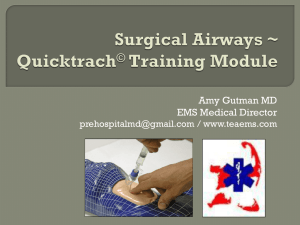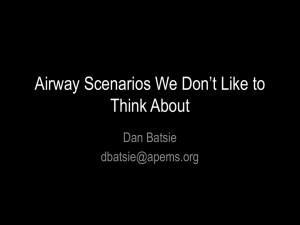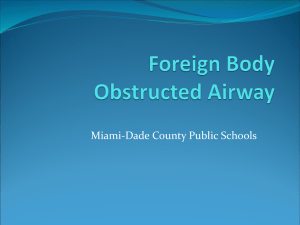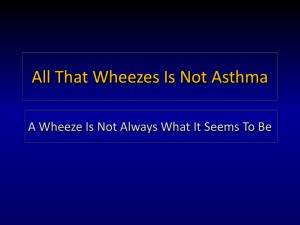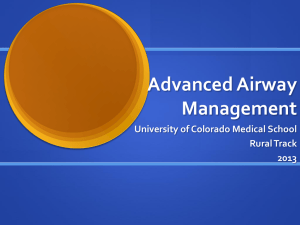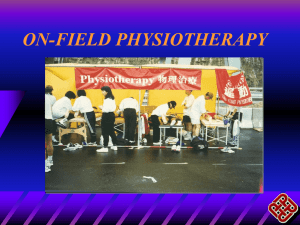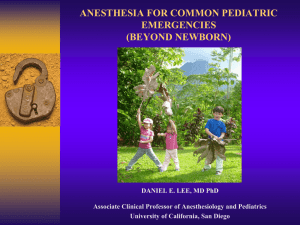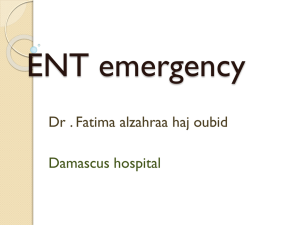Device for Aid in Neonatal and Infant Resuscitation
advertisement
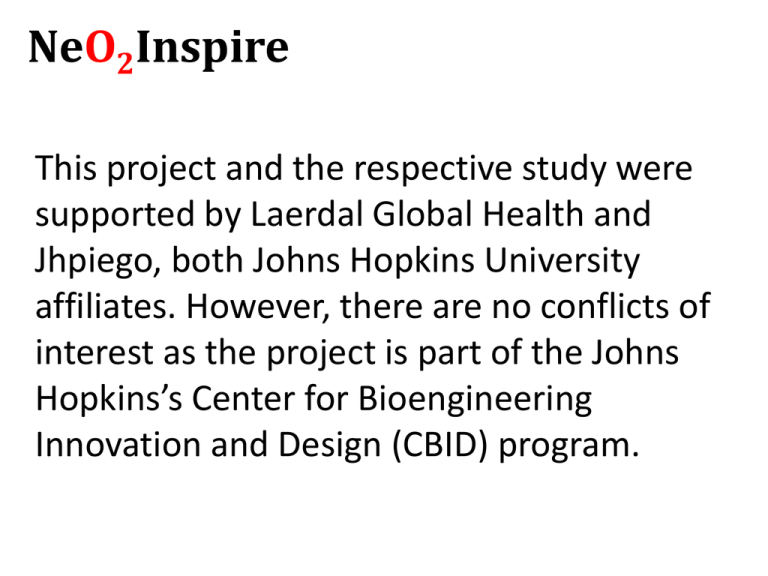
NeO2Inspire This project and the respective study were supported by Laerdal Global Health and Jhpiego, both Johns Hopkins University affiliates. However, there are no conflicts of interest as the project is part of the Johns Hopkins’s Center for Bioengineering Innovation and Design (CBID) program. NeO2Inspire Angelo Cruz Brian Gu Malvi Hemani Barbara Kim Taylor Lam Dr. Soumyadipta Acharya Dr. Robert Allen Dr. Utpal Bhalala Clinical Definition “Birth asphyxia [is] defined as the failure to establish breathing at birth.” - WHO Bulletin on Birth Asphyxia • Approximately 1 million deaths annually due to birth asphyxia • 99% deaths occur in low-resource areas NeO2Inspire’s Mission To improve the outcome of neonatal & infant resuscitation in developing countries by providing a simple and cost-effective technology to assist with healthcare worker performance. Current Standard of Care Performed by skilled birth attendants (SBAs) Current Standard of Care Ventilation Procedure Watch chest rise Assess tone and color - Warm and dry - Stimulate - Suction - Check heart rate - Monitor the Golden Minute 40 breaths/min Place mask properly Apply pressure Assess air leak Open airway Current Errors in Workflow • Incorrect placement of towel as shoulder raise to open airway • Mask seal not established properly • Failure to reroll the towel for patent airway due to lack of feedback Clinical Problem In the hands of SBAs, failure to open the airway is documented as one of the main causes for failed resuscitation. Insufficient training [1] Wall SN, et all. Int J Gynaecol Obstet. 2009. [2] Safar P, et all. J Appl Physiol. 1959. [3] Safar P. JAMA. 1958. Lack of operator feedback Complexity of procedure Our Proposed Solution Goals Constraints Create patent airway Operable by one person Reduce time spent on opening the airway Able to withstand current standard of disinfection procedure Less than $5 (affordable) Lightweight, so easily portable in purse or bag Our proposed device Airway Manipulation Hyper-extension Open Airway Flexion (Under-extension) Head-Tilt Angle Study Hyper-extension Open Airway Flexion (Under-extension) No previous data to define angle for these positions. Performed retrospective MRI study to validate and define the head-tilt angle required for airway patency in neonates and infants (0-12 months of age). Head-Tilt Angle Study 3 1 angle 2 • Head-tilt angle was measured as the angle between occipito-ophisthion line and ophisthion-C7 spinous process line. • Three measures were used to quantify airway patency: 1) Antero-posterior (AP) diameter of the airway at the level of palate 2) Antero-posterior (AP) diameter of the airway at the tongue level 3) Lateral diameter of the airway at tongue level Findings from Head-Tilt Study 66 neonates and 17 infants: • Closed airway can be due to either flexion or hyper-extension • Angle for airway patency is similar for neonates and infants • Validated that device can pertain to children 0-12 months • No correlation between mean head-tilt angle and either gestational age or weight of the child • Validated that device can pertain to all children 0-12 months regardless of prematurity and weight Open Airway: 121.90 ± 11.18* *Associated with open airway in spontaneously breathing, sedated neonates and infants Flexion Closed Airway: 136.88 ± 7.32 Hyper-Extended Closed Airway: 101.73 ± 8.31 Our Solution Our proposed solution attempts to address points of difficulty in the neonatal resuscitation protocol. Airway Mat Hospitals / Health Centers Box Mat Home Births Airway Mat Box Mat Setting: Primary and Secondary Hospital Settings, Community Health Centers • • • • • Cost: $1.71 Angled at 121.9 degrees to ensure airway patency Applicable for both neonates and infants (0-12 months of age) Reduces required training Smooth addition to current workflow Airway Mat Box Mat Setting: Home Births, Community Center Clinics • • • • Cost: $2.40 Same features as airway mat “Box” aspect allows for easy portability Enough storage room inside box for resuscitation tools (suction penguin, heating pads, BVM) Future Work IRB-approved human study to validate usage of device on neonates and infants. IRB-approved field study to validate clinical application of device in community centers and hospitals in developing countries. Develop Manufacturing Protocol Acknowledgements Undergraduate Members Sponsors and Mentors Priya Arunachalam Taylor Lam Dr. Utpal Bhalala Alisa Brown Karina Munoz Dr. Soumyadipta Acharya Steven Chen Christopher Petrillo Dr. Robert Allen Divya Gutala Josh Punnoose Kristy Peterson Grant Kitchen Meehir Shah Helge Myklebust Christine Yu Sunny Chen Sheena Currie Dr. Kusum Thapa Funding Sources Medical Educational Perspectives – $500.00 Jhpiego – Travel Grants Laerdal Global Health – $200.00 CBID – $1,500.00 Questions? APPENDIX Questions? References [1] Wall SN, Lee AC, Niermeyer S, English M, Keenan WJ, Carlo W, Bhutta ZA, Bang A, Narayanan I, Ariawan I, Lawn JE. Neonatal resuscitation in low-resource settings: what, who, and how to overcome challenges to scale up? Int J Gynaecol Obstet. 2009;107:S47-62. [2] Safar P, Escarraga LA, Chang F. Upper airway obstruction in the unconscious patient. J Appl Physiol 1959; 14(5):760-764. [3] Safar P. Ventilatory efficacy of mouth-to-mouth artificial respiration. Airway obstruction during manual and mouth-to-mouth artificial respiration. JAMA 1958; 167 (3): 335-341. Airway Mat Price Breakdown Purpose Material Cost/Device* Rigid plastic Polypropylene $1.50 Padding TPE Mat $0.21 TOTAL * Assuming that 10,000 devices are manufactured $1.71 Box Mat Price Breakdown Purpose Material Cost/Device* Rigid plastic Polypropylene $2.00 Padding TPE Mat $0.21 Corners Screws/Corner Attachments $0.19 TOTAL * Assuming that 10,000 devices are manufactured $2.40

